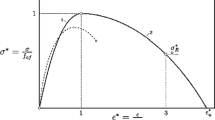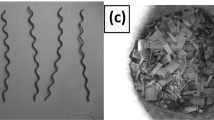Abstract
Concrete is a brittle material with much lower strength in tension as compared to that in compression. Adding fibres into concrete mix has been intensively investigated to increase the ductility, the crack control and energy absorption capabilities. A new type of steel fibre with spiral shape has been proposed recently. It has been demonstrated by laboratory tests that the spiral-shaped fibres have larger displacement capacity and provide better bonding into the concrete mix compared to other types of fibres such as hooked-end, deformed and corrugated fibres. The present study carries out drop-weight impact tests to study the structural responses of concrete beams reinforced with different types of steel fibres. Plain concrete and concrete reinforced by the commonly used hooked-end steel fibres and the proposed spiral-shaped steel fibres were tested. Two volume fractions, i.e. 0.5 and 1.0 %, of fibres were used to prepare steel fibre reinforced concrete (SFRC) specimens. Ø100–200 mm cylindrical specimens were also prepared and tested to determine the static properties of the concretes. Centre-point flexural tests were conducted on 100 × 100 × 350 mm beams with span length of 300 mm under drop-weight impact loads. The static tests were carried out using hydraulic testing machine and the impact tests were conducted using an instrumented drop-weight testing system. A 15.2 kg hard steel was used as the drop-weight impactor. Two drop heights, namely 0.5 and 1.0 m, were adopted in performing the repeated impact tests. The high-speed camera, fast-response load cells and laser linear variable differential transformers were used to record the failure processes, forces and displacements of the tested specimens under impact loads. The force–displacement relations and the corresponding energy absorption capabilities of the SFRC beams were obtained, compared and discussed. The advantage and effectiveness of the spiral-shaped steel fibres in increasing the performance of SFRC beam elements under impact loads are examined.

























Similar content being viewed by others
References
Brandt AM (2008) Fibre reinforced cement-based (FRC) composites after over 40 years of development in building and civil engineering. Compos Struct 86:3–9
Romualdi JP (1963) Mechanics of crack arrest in concrete. J Eng Mech Div ASCE Proc 89(EM3):147–168
Gao J, Sun W, Morina K (1997) Mechanical properties of steel fiber-reinforced, high-strength, lightweight concrete. Cem Concr Compos 19:307–313
Balendran RV, Zhou FP, Nadeem A, Leung AYT (2002) Influence of steel fibres on strength and ductility of normal and lightweight high strength concrete. Build Environ 37:1361–1367
Ravindrarajah RS, Tam CT (1984) Flexural strength of steel fibre reinforced concrete beams. Int J Cem Compos Lightweight Conc 6(4):273–278
Fattuhi NI, Hughes BP (1982) Effect of beam dimensions and concrete filling sequence on the flexural strength of steel fibre reinforced concrete beams. Int J Cem Compos Lightweight Concr 4(2):117–122
Qian C, Indubhushan P (1999) Properties of high-strength steel fiber-reinforced concrete beams in bending. Cem Concr Compos 21:73–81
Abrishami HH, Mitchell D (1997) Influence of steel fibers on tension stiffening. ACI Struct J 94(6):769–775
Wafa FF, Ashour SA (1992) Mechanical properties of high-strength fiber reinforced concrete. ACI Mater J 89(5):449–455
Bischoff PH, Perry SH (1991) Compressive behaviour of concrete at high strain rates. Mater Struct 24:425–450
Hao Y, Hao H, Zhang XH (2012) Numerical analysis of concrete material properties at high strain rate under direct tension. Int J Imp Eng 39:51–62
Hao Y, Hao H, Jiang GP, Zhou Y (2013) Experimental confirmation of some factors influencing dynamic concrete compressive strengths in high-speed impact tests. Cem Concr Res 52:63–70
Butler JE, Keating J (1981) Preliminary data derived using a flexural cyclic loading machine to test plain and fibrous concrete. Mater Struct 14(1):25–33
Mellinger FM, Birkimer DL (1996) Measurement of stress and strain on cylindrical test specimens of rock and concrete under impact loading. Technical Report No 4-46, Ohio River Division Laboratories, Corps of Engineers
Banthia N, Chokri K, Ohama Y, Mindess S (1994) Fiber-reinforced cement based composites under tensile impact. Adv Cem Based Mat 1:131–141
Körmeling HA, Reinhardt HW (1987) Strain rate effects on steel fibre concrete in uniaxial tension. Int J Cem Compos Lightweight Concr 9(4):197–204
Holschemacher K, Mueller T, Ribakov Y (2010) Effect of steel fibres on mechanical properties of high-strength concrete. Mater Des 31:2604–2615
Bindiganavile V, Banthia N (2001) Polymer and steel fiber-reinforced cementitious composites under impact loading- part 1: bond-slip response. ACI Mater J 98(1):10–16
Bindiganavile V, Banthia N (2001) Polymer and steel fiber-reinforced cementitious composites under impact loading- part 2: flexural toughness. ACI Mater J 98(1):17–24
Kim DJ, El-Tawil S, Naaman AE (2009) Rate-dependent tensile behavior of high performance fiber reinforced cementitious composites. Mater Struct 42:399–414
Lok TS, Zhao PJ (2004) Impact response of steel fiber-reinforced concrete using a split Hopkinson pressure bar. J Mater Civil Eng ASCE 16(1):54–59
Li VC, Yang EH, Li M (2008) Field demonstration of durable link slabs for jointless bridge decks based on strain-hardening cementitious composites- phase 3: shrinkage control. Michigan Department of Transportation
Xu Z, Hao H, Li HN (2012) Experimental study of dynamic compressive properties of fibre reinforced concrete material with different fibres. Mater Des 33:42–55
Xu Z, Hao H, Li HN (2012) Dynamic tensile behaviour of fibre reinforced concrete with spiral fibres. Mater Des 42:72–88
Hao Y, Hao H (2013) Dynamic compressive behaviour of spiral steel fibre reinforced concrete in split Hopkinson pressure bar tests. Constr Build Mater 48:521–532
ASTM International (2006) Standard test method for compressive strength of cylindrical concrete specimens 2006. Designation: C 39/C 39M
Davies JD, Bose DK (1968) Stress distribution in splitting tests. ACI J 65:662–669
ASTM International (2004) Standard test method for splitting tensile strength of cylindrical concrete specimens 2004. Designation: C 496/C 496M
Tang T (1994) Effects of load-distributed width on split tension of unnotched and notched cylindrical specimens. J Test Eval 22(5):401–409
ACI 544.2R-89 (1999) Measurement of properties of fiber reinforced concrete
Chen G, Hao Y, Hao H (2014) 3D meso-scale modelling of concrete material in spall tests. Mater Struct. doi:10.1617/s11527-014-0281-z
Acknowledgments
The financial supports for carrying out this study from Australian Research Council (Grant No: DP130104332) and China National Natural Science Foundation (Grant No: 51227006) are acknowledged.
Author information
Authors and Affiliations
Corresponding author
Rights and permissions
About this article
Cite this article
Hao, Y., Hao, H. & Chen, G. Experimental investigation of the behaviour of spiral steel fibre reinforced concrete beams subjected to drop-weight impact loads. Mater Struct 49, 353–370 (2016). https://doi.org/10.1617/s11527-014-0502-5
Received:
Accepted:
Published:
Issue Date:
DOI: https://doi.org/10.1617/s11527-014-0502-5




